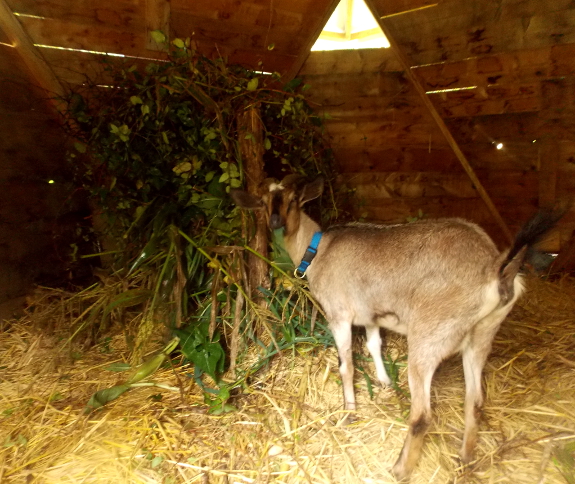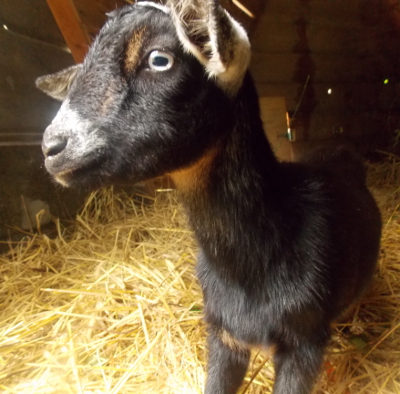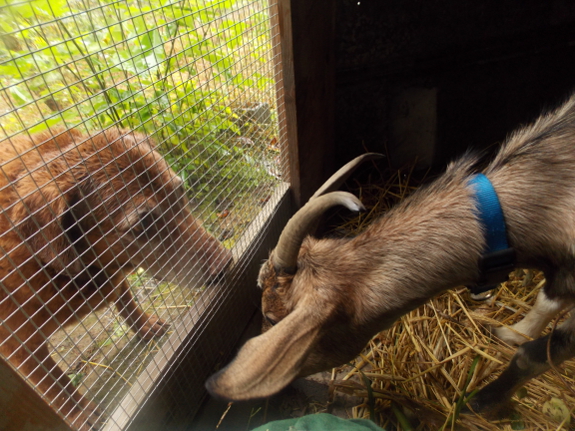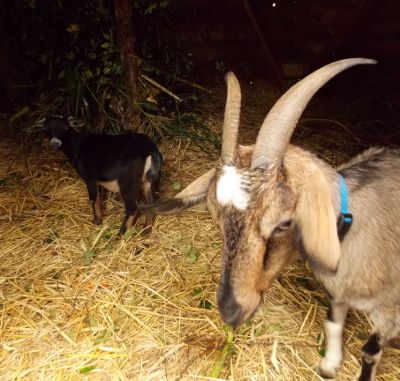
Pros and cons of feeding grain to goats

Feeding goats naturally
seems to be a complicated subject, which I'm just starting to wrap my
head around (so readers should feel free to jump in if you think I'm off
base). From what I understand, the ancestors of our cultivated
goats would have been eating browse --- rough plant matter like tree
leaves, blackberry brambles, and so forth. They needed to consume
lots of this roughage to get enough energy to live and grow, and their
digestive system has evolved to require that kind of bulk fiber.
 Grain
is a recent introduction to the goat's diet, and while it can help a
doe keep on weight when she's producing lots of milk, grain can also be
hard on a goat's gut since she isn't really adapted to eat it.
That makes the supplement more of a tradeoff than you'd find with your
dogs --- fancier rations will probably just make your canines happy, but
more grain can make a goat sick.
Grain
is a recent introduction to the goat's diet, and while it can help a
doe keep on weight when she's producing lots of milk, grain can also be
hard on a goat's gut since she isn't really adapted to eat it.
That makes the supplement more of a tradeoff than you'd find with your
dogs --- fancier rations will probably just make your canines happy, but
more grain can make a goat sick.
So why give her any grain
at all? Humans generally want the most that we can get out of our
livestock, so we've bred dairy goats to produce much more milk than
their ancestors would have in the wild. Producing that milk
requires extra energy and protein, and most goats will get really skinny
if milked hard on pasture alone. Think of this as a bit like
Appalachian Trail thru-hikers --- they physically can't
carry enough food to keep them well nourished while on the trail, so
they often gorge on ice cream and other concentrates when they hit
towns. Grain is the dairy goat's ice cream --- it helps a doe put
back on the pounds, but it's not necessarily good for her in the long
run.
Now, there are alternatives to grain that still provide concentrated nutrition. For example, Nita provided some excellent guest information in my ebook $10 Root Cellar
about how she grows and prepares carrots, beets, parsnips, rutabagas,
and (sometimes) mangels to keep her milk cow in fine flesh while milking
over the winter. And there's also something to be said for
choosing individual milking animals that have well-developed rumens from
a childhood on pasture and that don't produce quite as much milk, since
animals like this probably won't need as much nutritional
supplementation. But, in the end, most people end up giving at
least a little bit of grain to their milking animals at certain times.

Returning to your point, there is
some controversy about when a doe most needs extra nutrition --- while
milking heavily, or when pregnant. Most sources will only mention
the latter, but others tell you that it's imperative to have your doe in
relatively good condition at the start of her pregnancy if you want her
to easily get and stay pregnant. The trouble is that if you feed
much grain while she's actually pregnant, the kid(s) will grow extra
large, which can result in complications during birth. So, your
best bet is to get your doe in tip-top shape before she gets pregnant,
to cool it on the grain while she's actually pregnant, then to pick back
up with grain (or other supplements) in proportion to how much milk
she's producing after she gives birth.
Of course, all of this is
still book learning at the moment. In a year or two, I'll
probably laugh at the lack of nuance in my understanding of the subject
but, for now, I'll keep Abigail's treats to a minimum but will provide
her with lots of excellent browse to keep her healthy.

(As a side note, during
day one with two goats, it rained like crazy, so our girls have been
enjoying room service --- masses of Japanese honeysuckle torn off the
side of the barn, a handful of oat leaves, several sweet-corn stalks,
two sunflower plants, some comfrey leaves, and a sorghum stalk. Abigail thinks the oats are the best, followed by honeysuckle and comfrey, while our little doeling
still looks a bit befuddled by her new home but chowed down on quite a
bit of honeysuckle. Hopefully it'll dry off enough to get them out
on pasture for a better quality photo shoot soon!)
Want more in-depth information? Browse through our books.
Or explore more posts by date or by subject.
About us: Anna Hess and Mark Hamilton spent over a decade living self-sufficiently in the mountains of Virginia before moving north to start over from scratch in the foothills of Ohio. They've experimented with permaculture, no-till gardening, trailersteading, home-based microbusinesses and much more, writing about their adventures in both blogs and books.
Want to be notified when new comments are posted on this page? Click on the RSS button after you add a comment to subscribe to the comment feed, or simply check the box beside "email replies to me" while writing your comment.

I read this entry with interest, although I have no goats. I too thought that grain during pregnancy and lactation was wise. I read the blog of a crofter in Scotland, and he raises goats for milk and cheese, here is a link to comments he had on the subject:
http://craigardcroft.blogspot.com/2014/02/ultra-sound-scan-for-goats-one-pair-of.html
I can only speak in general livestock terms because I don't have goats, but the single best thing you can do nutrition-wise is have good loose minerals available free choice. Countryside Organics might have what you need or service a feed store near you. Good minerals also give the manure a boost too for remineralization purposes.
Speaking from cow experience here too, so this may not apply but the stories of fetuses growing too large in late gestation because of overfeeding is an old wive's tale. Of course you don't want to overfeed, because it may cause problems with labor, but usually it's bad breeding choice that causes the babies to be too big.
Nita --- Very timely comment since my goal for today (and my post for tomorrow) is researching goat minerals. I'm leaning toward a complicated arrangement with free-choice goat minerals in one feeder, plain salt in another, and kelp in a third. Over-complicated, do you think? (Or not complicated enough? )
)
And very good to hear your take on the feeding while pregnant issue.
Hi
There aint a lot of feed value in browse come spring , just dried out dead stuff So feed hay , it dont need to be "Quality " hay just the cheap stuff that aint been wet , (not Musty ) then add a little good feed , I use horse and mule (they love the molases and i add diotomacious earth for a week once a month to head off worms ) , about a pound between four of them twice a day and s little alfalfa pellets when i start milking , about a coffee cup per goat per day , that has most of the minerals goats need , goats will waste hay so set op a feeder where they cant pull too much out and trample it into the dirt , mine is made from 4 inch hog pannel , small enough to stop waste yet big enough to get their nose through . basicly just watch them ,if they loose condition feed a little more , keep them dry with a warm shelter secure from varmits and enjoy them .
I don't go overboard with all the compartments since I move my mineral box each day and it has to be easy to move and cow-proof (goats are a little easier on stuff), I've seen stock with a plethora of mineral choices and they still look like they aren't getting what they need, you see rough coats, general unthriftiness etc. The most important thing is to make sure you don't mix the salt in with the other minerals because it can inhibit the animal's intake of the other minerals it needs. But like all things, minerals for stock is pretty subjective and some folks swear by certain things and others swear by the opposite. The best thing is to buy in small amounts, offer as much as you can afford, and watch your animals for signs they are getting what they need or not getting what they need.
My standbys are Redmond TM salt or Sea-90 salt (if I can get it) Icelandic kelp, Fertrell Nutribalancer (contains some Redmond salt and kelp), and sometimes Copper Sulfate, Azomite, or sulfur. Depending on the time of year and quality of feed, intake varies quite a bit.
You will find this an enlightening journey
A few eclectic thoughts:= grains are really lousy sources of nutrition. A pile of grain is essentially a pile of sugar. Too much grain in a ruminant's diet may deter it from eating the healthier hay/browse it needs to keep the gut flora right. OTOH- the carbs do help spare protein to defer it into milk & muscle production. A little moderation is always a good thing.
=how can inorganic salts be "organic"?